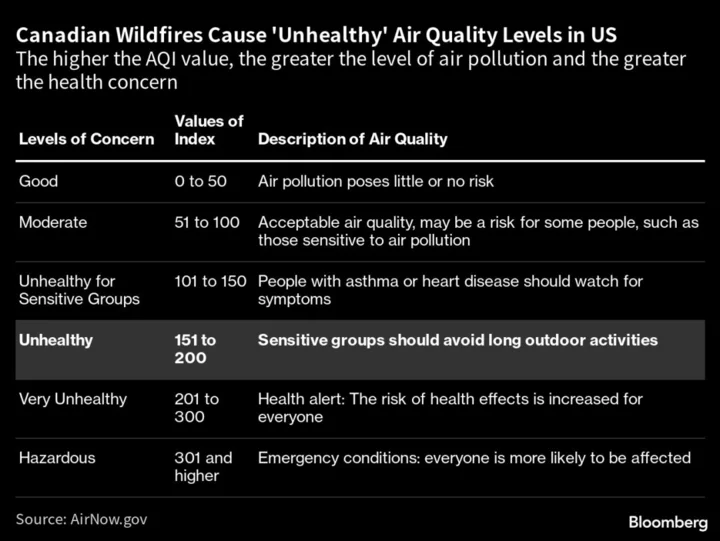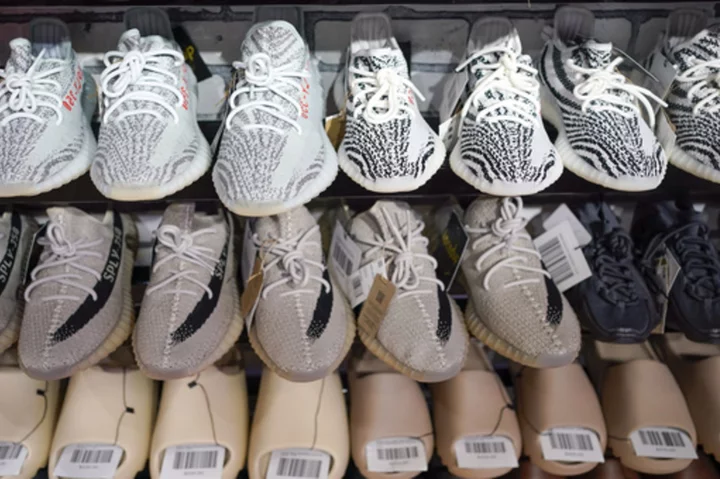Millions of Americans woke up to apocalyptic, orange skies Wednesday as thick smoke from wildfires in Canada moved across the US Northeast, spawning air quality warnings from Massachusetts to Washington, DC.
In New York, air pollution reached record — and dangerous — levels, putting the city atop the world’s worst for air quality. State and local officials told residents to mask up and stay indoors, but many have questions about how the smoke will affect them, and what is and isn’t safe to do right now.
Read more: Google Tells Workers Stay Home; Comer Leaves Stage: Smoke Latest
1. What is particulate matter and why is it dangerous?
Wildfire smoke is hazardous in part because it contains tiny, inhalable particles called PM2.5. The same type of air pollution is emitted when cars burn gasoline or power plants burn coal for fuel, but it’s particularly acute during wildfires.
While people with health conditions like asthma and heart disease are at elevated risk, even otherwise healthy people may experience symptoms like coughing, sneezing and eye irritation when exposed to particulate matter. Health experts recommend everyone limit their time outdoors when air quality is seriously bad, like it is in the US Northeast right now, and steer clear of activities like running outdoors until things improve.
Read more: How Wildfire Smoke Impacts Human Health
2. What is safe at the moment? Is eating lunch outside OK? What about playing tennis?
The short answer: At-risk groups, including children, should limit activity outdoors until air quality levels improve.
In cities like New York, where it’s considered hazardous, being outside for extended periods of time is a no-go even for those who are physically fit.
People should consult the US Environmental Protection Agency’s real-time measurements of pollution levels, known as the Air Quality Index, to make decisions about what is and isn’t safe to do, says Stephanie Lovinsky-Desir, chief of pediatric pulmonology at Columbia University Medical Center.
“You can protect yourself by just knowing what the air quality is and to stay indoors and try to avoid exposure” if AQI values are high, she says. They can change throughout the day, so checking frequently is best to determine what types of activities are OK to do.
For example, the AQI in New York City was about 392 at 3:00 p.m. on Wednesday, a level considered to be hazardous for all groups, including healthy people. When AQI levels are that high, the EPA suggests that everyone avoid all physical activity outdoors.
3. What does the AQI number even mean? Is 200 equivalent to smoking a pack of cigarettes in a day?
The toxins in cigarettes and wildfire smoke aren’t exactly the same, but comparing them is the best analogy researchers have to communicate the harmful effects of poor air quality, experts say.
An AQI of about 20 is equivalent to smoking one cigarette per day, according to researchers from Stanford University. Communities exposed to wildfire smoke causing an AQI of 150 for several days is equivalent to about seven cigarettes a day, the researchers said, though that’s only if you’re outside the entire time.
Still, being indoors doesn’t provide 100% protection due to leakage. For those looking for an added layer of protection, high-efficiency particulate air filters, or HEPA filters, are good to keep on hand.
Read more: How Much Are You ‘Smoking’ by Breathing Urban Air?
3. What can New Yorkers do to protect themselves? Does wearing a mask outside help?
The easiest thing people can do is stay indoors and make sure all windows are closed.
Wearing a high-quality, well-fitted mask like a KN95 or N95 mask is a good option for those who need to commute to work or be outside for any reason. Healthy New Yorkers should take precautions to limit exposure to harmful air, too.
People at particularly high risk right now are young children, older adults, and people with underlying health conditions. For those groups, limiting time spent outside is critical when air quality is bad.
5. What should parents of young children do?
Experts recommend that children, especially those with asthma, stay indoors and wear well-fitted N95 or KN95 masks if they have to go outside. Parents should monitor symptoms and get medical help if a child has trouble breathing, is sleepy or won’t eat or drink, according to the Centers for Disease Control and Prevention.
Children face greater long-term consequences from wildfire smoke because their lungs and other organs are still developing. They breathe faster than adults, so they inhale more pollutants. Research has shown that any exposure to these pollutants in childhood, even just for a day, can impact long-term health.
Columbia’s Lovinsky-Desir, who is based in New York, says she talked to her son’s baseball coach about rescheduling practice so parents weren’t forced to make the hard decision about whether or not to keep their kid home from activities.
Read more: Wildfire’s Toxic Legacy Has Children Gasping for Air Years Later
6. What about pets? Is it safe to take my dog for a walk?
“Smoky conditions triggered by wildfires can affect cats and dogs just like humans, and pet owners should act accordingly,” said Thomas Edling, American Humane’s chief veterinary officer, in a statement.
“Shorter walks to avoid strained breathing and monitoring your animal for coughing, sneezing, and general respiratory issues is recommended,” he said. Older animals and those with inherent breathing problems, like French bulldogs, should be under even closer observation.
7. For elderly or vulnerable people, is the only option staying indoors until this is over?
Everyone, especially young, elderly or vulnerable people, should stay inside as much as possible when the air quality is unhealthy or worse.
Pay close attention to any symptoms, including difficulty breathing or nasal congestion.
If you must go outside, “take it slow, don’t over-exert yourself. Put a mask on and limit the time and exposure that you have outside,” said Rahul Sharma, the emergency physician-in-chief at New York Presbyterian-Weill Cornell Medical Center. “But there’s really nothing else to do until this smoke and everything goes away.”
Read More: Air Pollution Linked to Higher Dementia Risk in Harvard Analysis









